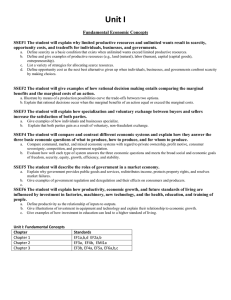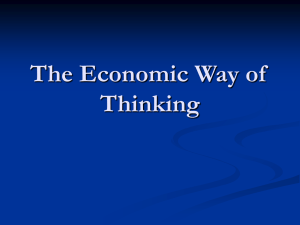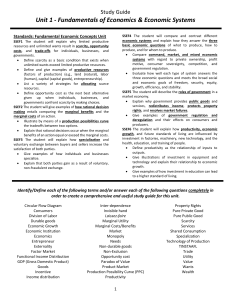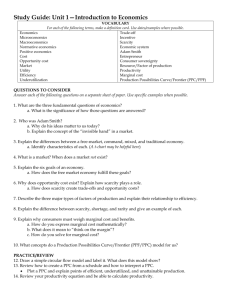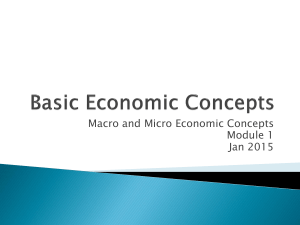Unit 1 Study Guide - Fundamental Concepts
advertisement
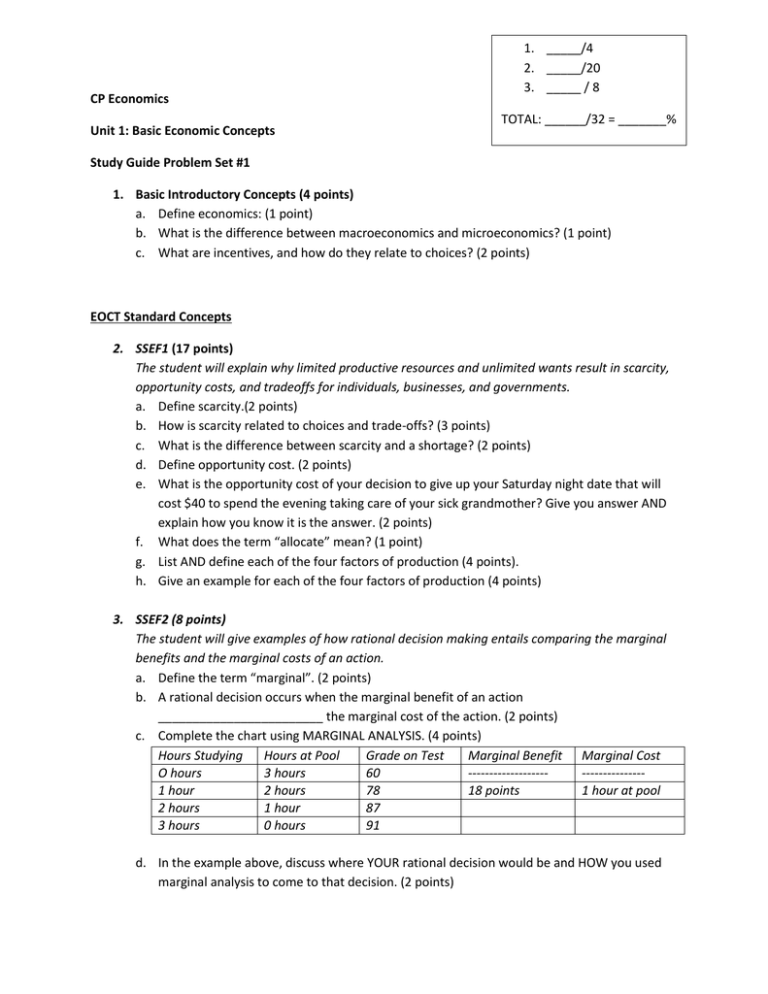
CP Economics Unit 1: Basic Economic Concepts 1. _____/4 2. _____/20 3. _____ / 8 TOTAL: ______/32 = _______% Study Guide Problem Set #1 1. Basic Introductory Concepts (4 points) a. Define economics: (1 point) b. What is the difference between macroeconomics and microeconomics? (1 point) c. What are incentives, and how do they relate to choices? (2 points) EOCT Standard Concepts 2. SSEF1 (17 points) The student will explain why limited productive resources and unlimited wants result in scarcity, opportunity costs, and tradeoffs for individuals, businesses, and governments. a. Define scarcity.(2 points) b. How is scarcity related to choices and trade-offs? (3 points) c. What is the difference between scarcity and a shortage? (2 points) d. Define opportunity cost. (2 points) e. What is the opportunity cost of your decision to give up your Saturday night date that will cost $40 to spend the evening taking care of your sick grandmother? Give you answer AND explain how you know it is the answer. (2 points) f. What does the term “allocate” mean? (1 point) g. List AND define each of the four factors of production (4 points). h. Give an example for each of the four factors of production (4 points) 3. SSEF2 (8 points) The student will give examples of how rational decision making entails comparing the marginal benefits and the marginal costs of an action. a. Define the term “marginal”. (2 points) b. A rational decision occurs when the marginal benefit of an action ________________________ the marginal cost of the action. (2 points) c. Complete the chart using MARGINAL ANALYSIS. (4 points) Hours Studying Hours at Pool Grade on Test Marginal Benefit Marginal Cost O hours 3 hours 60 --------------------------------1 hour 2 hours 78 18 points 1 hour at pool 2 hours 1 hour 87 3 hours 0 hours 91 d. In the example above, discuss where YOUR rational decision would be and HOW you used marginal analysis to come to that decision. (2 points) 1. 2. 3. 4. CP Economics Unit 1: Basic Economic Concepts __________/7 __________/2 __________/2 __________/2 Total: _______/13 = _______% Study Guide Problem Set #2 SSEF2: Illustrate by means of a production possibilities curve the tradeoffs between two options. B A E C F D 1. Complete each of the following tasks using Figure 1 above. a. How is the concept of scarcity illustrated on the PPC above? (1 point) b. What trade-offs are shown on the PPC above? (2 points) c. What do points A, B, C, and D have in common? (1 point) d. What is happening at point F? (1 point) e. What is happening at point E? (1 point) f. What is the opportunity cost of moving from point A to point B? (1 point) 2. Assume that there is a major change in agricultural technology that leads to a greater supply of food products. Re-draw the graph above and show the shift that would occur (2 points). Note** You DO NOT have to draw the numbers, just the general shape of the curve and label the axes. 3. Assume that the society above can no longer obtain the natural resources it needs to build weapons of mass destruction. Re-draw the graph and show the shift that would occur (2 points). 4. Assume that the society above experiences an educational revolution that leads to a great number of new scientists in technological fields who make great discoveries. Re-draw the graph and show the shift that would occur. (2 points) 1. _____/6 2. _____/6 3. _____/3 CP Economics 4. _____/10 Unit 1: Basic Economic Concepts Total: ________/25 = _______% Study Guide Problem Set #3 1. SSEF3 Specialization and Voluntary Exchange a. Give two examples of how individuals and/or businesses specialize. (2 points) b. What does the phrase “voluntary exchange” mean? (1 point) c. What does it mean for exchange to be “non-fraudulent”? (1 point) d. Explain why both parties who engage in voluntary, non-fraudulent exchange benefit. (2 points) 2. SSEF6 Productivity and Economic Growth a. Define productivity (1 point) b. How does increased productivity lead to economic growth? (2 points) c. List three specific ways societies can improve their productivity. (3 points) 3. SSEIN1 Comparative and Absolute Advantage a. Define comparative advantage (1 point) b. Define absolute advantage. (1 point) c. State the Law of Comparative Advantage. (1 point) 4. SSEIN1 Comparative Advantage Application Yearbook Staff Members Captions Written per Hour Sara Rob 4 8 Pictures Cropped and Pasted per Hour 5 8 a. Who has the absolute advantage in cropping and pasting pictures? How do you know? (2 points) b. Calculate the opportunity cost for each yearbook member in each activity. SHOW YOUR WORK. ( 4 points) c. Who has the comparative advantage in writing captions? How do you know? (2 points) d. Who has the comparative advantage in cropping pictures? How do you know? (2 points)
